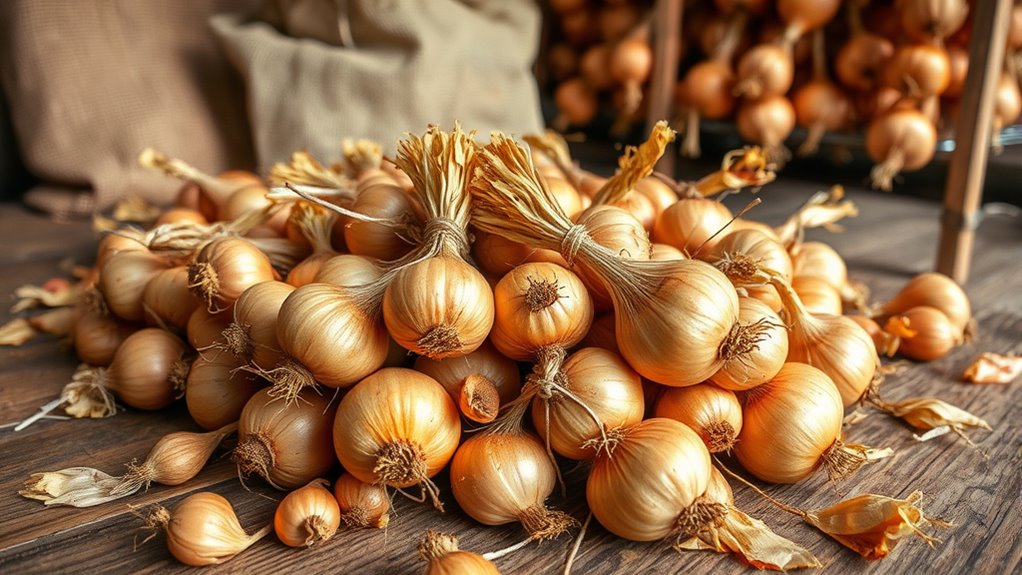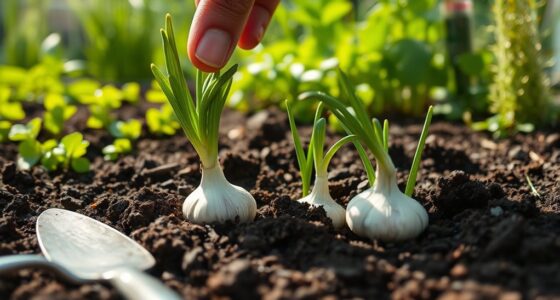To cure onions for long-term storage, start by selecting healthy, mature bulbs with no damage. Harvest when tops turn brown and wait until the necks are dry. Set up a clean, well-ventilated area and arrange your onions on racks or baskets, keeping them separate for good air circulation. Confirm the environment is around 75°F with moderate humidity. Proper curing prevents rot and extends shelf life—keep going to learn more about perfecting this process.
Key Takeaways
- Select healthy, mature onions with no damage or disease for optimal curing.
- Harvest onions when tops fall over and turn brown, indicating maturity.
- Clean and trim roots carefully, removing loose outer layers to prevent mold.
- Arrange onions in a well-ventilated, dry area with good airflow for even drying.
- Ensure onions are fully dry before storing in a cool, dark, ventilated space to extend shelf life.
Selecting the Best Onions for Curing
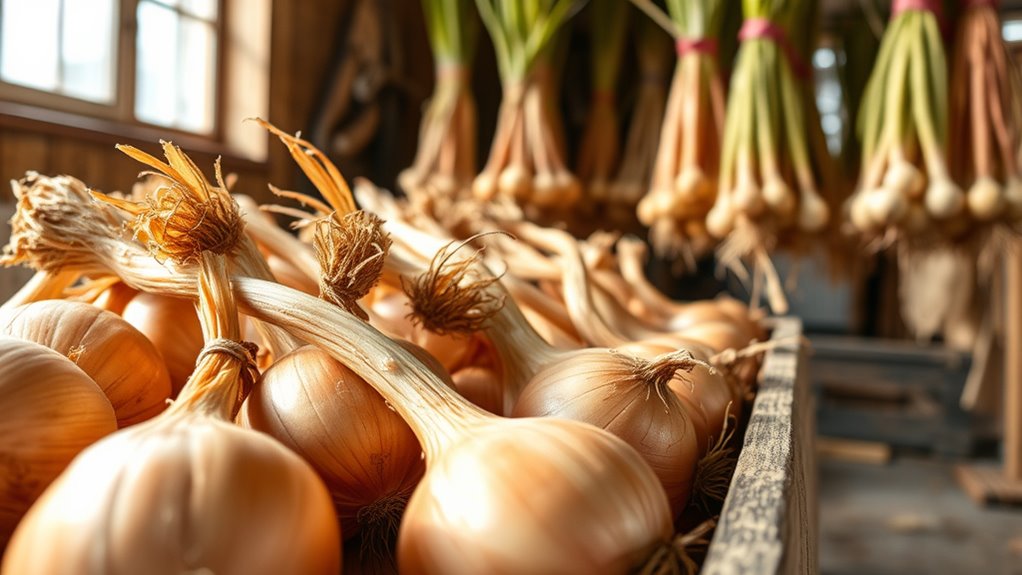
To guarantee your onions store well long-term, it’s crucial to start with the right ones. Choose healthy, mature onions with no signs of disease or damage, as these will cure better and last longer. Different onion varieties, such as yellow, red, or white, may require slightly different curing techniques, but all benefit from proper selection. Look for onions with fully developed bulbs that feel firm and dry. Avoid onions with soft spots or blemishes. Proper curing begins with selecting onions that are at peak maturity, ensuring they have the right size and color. Additionally, understanding glycolic acid benefits can inspire sustainable practices that support your gardening efforts. Selecting quality produce is essential for successful long-term storage because it directly impacts the curing process and shelf life. This initial step helps prevent spoilage and sets the foundation for successful long-term storage. By choosing the best onions, you’ll improve your chances of a successful curing process and extended shelf life.
Harvesting Onions at the Right Time
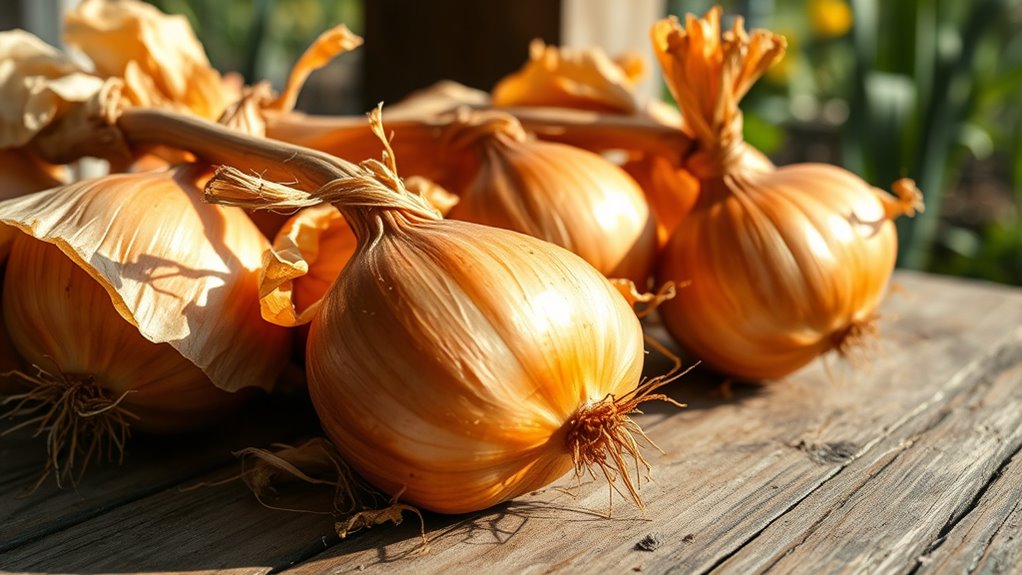
Wondering when to harvest your onions? The key is observing the harvest timing for different onion varieties. Most onions are ready when the tops start to fall over and turn brown. For short-day varieties, wait about 100-110 days; long-day types need 110-125 days. Keep an eye on the foliage—once it begins to yellow and wither, it’s time to harvest. Use this table as a guide:
| Onion Variety | Approximate Harvest Timing | Signs to Harvest |
|---|---|---|
| Short-day onions | 100-110 days | Tops yellow, fall over |
| Long-day onions | 110-125 days | Tops yellow, wither, bulbs mature |
| Storage onions | 110+ days | Fully mature, tops brown and dry |
| Sweet onions | 90-100 days | Slight yellowing, bulbs swell |
| Red onions | 105-120 days | Tops fall, bulbs firm and shiny |
Harvest at the right time to guarantee the best long-term storage. Proper harvesting ensures your onions will be well-prepared for long-term storage and preservation. Additionally, maintaining proper drying techniques after harvest helps prevent spoilage during storage. Proper curing is essential to prevent spoilage and extend the usability of your stored onions. Understanding the importance of post-harvest handling can further improve storage longevity.
Preparing Your Workspace for Curing
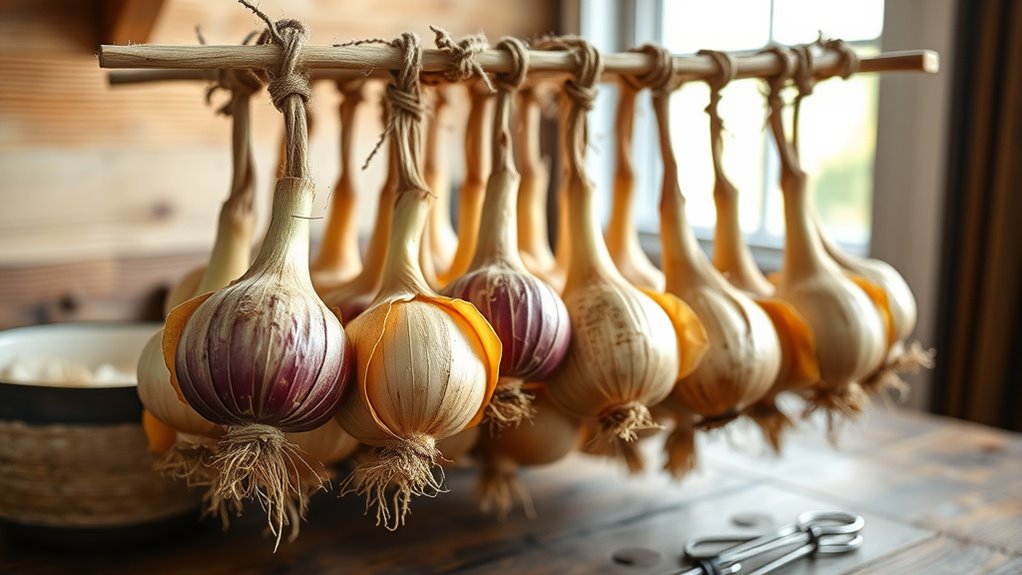
Before you start curing your onions, it’s essential to set up a clean, well-ventilated workspace that promotes proper drying. Confirm the area is free of dirt and debris, and avoid dampness to prevent mold. Good airflow is vital; consider using fans or open windows. Soil preparation nearby should be minimal to prevent contamination. Focus on pest control by removing pests and sealing entry points to avoid infestations that could spoil your onions. To create an ideal environment, also consider:
- Keeping the workspace dry and dust-free
- Using clean, breathable surfaces for curing
- Ensuring adequate ventilation for airflow
- Regularly monitoring for pests or mold
- Selecting areas with optimal ventilation and airflow to promote even drying. Additionally, choosing a space with consistent temperature helps prevent spoilage. Maintaining proper air circulation is essential for preventing rot and guaranteeing your onions dry evenly for long-term storage. Proper environmental conditions are crucial for successful curing and storage longevity, especially as the automation technologies in storage facilities continue to improve efficiency.
Cleaning and Trimming the Onions

Start by carefully removing any loose outer layers from your onions to prevent mold and rot. Next, trim the roots close to the bulb without damaging the skin, which helps with air circulation. These steps guarantee your onions stay fresh and ready for proper curing.
Removing Loose Layers
Removing loose layers is a crucial step in preparing onions for long-term storage, as it helps eliminate any damaged or shriveled outer skins that could harbor mold or bacteria. During onion peeling, carefully strip away the outermost layers, focusing on removing only the loose, papery skins that no longer serve a protective purpose. This process not only improves the onion’s appearance but also reduces the risk of spoilage. Keep in mind these key points:
- Layer removal reveals fresh, healthy tissue for better storage longevity
- Avoid cutting into the onion’s flesh to prevent premature spoilage
- Removing damaged layers prevents mold buildup
- Proper onion peeling ensures a cleaner, more durable onion for long-term storage
- Incorporating proper cleaning techniques can further enhance storage quality and prevent contamination. Additionally, understanding vegetable preservation methods can optimize storage outcomes.
Trimming Roots Properly
Properly trimming and cleaning the roots is essential for preparing onions for long-term storage, as it prevents dirt and bacteria from causing spoilage. Start by carefully removing any loose or damaged roots with clean scissors or pruning shears. Use a gentle brush or cloth to clean off remaining soil, ensuring no dirt remains that could harbor bacteria. When root trimming, avoid cutting too close to the bulb to preserve the root structure, which helps with root preservation and overall bulb health. Maintaining a clean, trimmed root system reduces the risk of mold and decay during storage. Be precise and gentle, focusing on removing only what’s necessary. Proper root trimming and cleaning set the stage for successful curing and long-term onion storage. Additionally, understanding GMC tuning can provide motivation to care for your produce with patience and dedication, much like nurturing a meaningful relationship.
Properly Arranging Onions for Curing
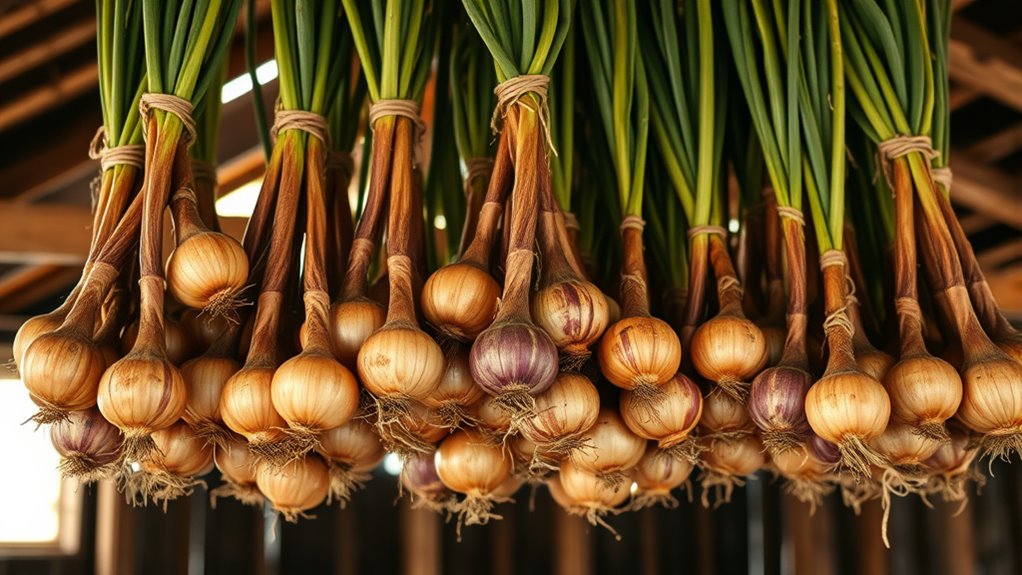
To guarantee your onions cure properly, you need to arrange them carefully. Choose a well-ventilated space to prevent moisture buildup, and keep the onions separate to avoid rotting. Using a supportive rack or baskets helps maintain good air circulation around each onion. Additionally, ensuring proper air circulation is essential for an even and effective curing process.
Choose a Well-Ventilated Space
Choosing a well-ventilated space is essential for successful onion curing because good airflow helps prevent mold and rot. Proper airflow management ensures the onions dry evenly and stay healthy during curing. To maximize ventilation techniques, select a space with good cross-ventilation or use fans if needed. Keep the area free of excess humidity, which can encourage mold growth. Consider these tips:
- Use open windows or vents to promote natural airflow
- Elevate onions on racks or screens for better air circulation
- Avoid overcrowding to prevent restricted airflow
- Control humidity levels with dehumidifiers if necessary
- Incorporating effective mixing techniques can further enhance airflow and drying efficiency.
These steps help maintain ideal airflow, ensuring your onions cure properly and remain in good condition for long-term storage. Proper ventilation techniques are key to a successful curing process.
Keep Onions Separate
Ensuring onions are kept separate during curing is essential for promoting even drying and preventing spoilage. When arranging your onions, avoid stacking or overcrowding, as this can trap moisture and lead to mold. Different onion varieties may have varying moisture levels and curing needs, so keep them organized accordingly. Use individual layers or small groups to allow proper air circulation around each bulb. Proper separation helps prevent bruising and reduces the risk of rot spreading between onions. If you’re curing multiple onion types, consider storing them in separate areas or containers. Maintaining good airflow around each onion ensures they dry uniformly and stay healthy, making your onions ideal for long-term storage. Additionally, paying attention to proper curing techniques can significantly extend their shelf life and quality. Implementing consistent temperature and humidity levels during curing also plays a crucial role in achieving optimal results, especially when considering air circulation and filtration to prevent mold and pests. Properly managing storage conditions is equally important for preserving onions after curing, and understanding moisture control is key to preventing spoilage during storage.
Use Supportive Rack or Baskets
Using a supportive rack or baskets during curing helps keep onions properly arranged and allows for ideal air circulation. This setup prevents moisture buildup and reduces rot risk. When choosing a supportive rack, guarantee it has good airflow and stability. Basket storage is also effective, as it supports even drying and easy handling. To maximize benefits:
- Arrange onions with space between each for airflow
- Avoid stacking onions directly on top of each other
- Use breathable materials like mesh or wire baskets
- Keep the support in a cool, dry, well-ventilated area
Proper arrangement with a supportive rack or baskets promotes uniform drying, ensuring your onions cure thoroughly and last longer in storage. This method is essential for healthy, long-term onion preservation.
Controlling Temperature and Humidity During Curing

Controlling temperature and humidity is essential during the curing process to prevent spoilage and promote proper drying of the onions. Keep the environment around 75°F (24°C) with low humidity, ideally between 65-70%. Too much moisture encourages disease, while excessive heat damages the onions. Use well-ventilated storage containers or racks to ensure air circulation. Proper airflow helps maintain consistent humidity levels and prevents mold growth.
| Temperature | Humidity | Tips |
|---|---|---|
| 75°F (24°C) | 65-70% | Use ventilated containers |
| Slightly higher | Slightly lower | Avoid damp areas |
| Cooler | Higher | Prevents sprouting |
| Warmer | Lower | Promotes rapid drying |
Staying vigilant with temperature and humidity supports disease prevention and ensures onions cure evenly for long-term storage.
Monitoring the Curing Process
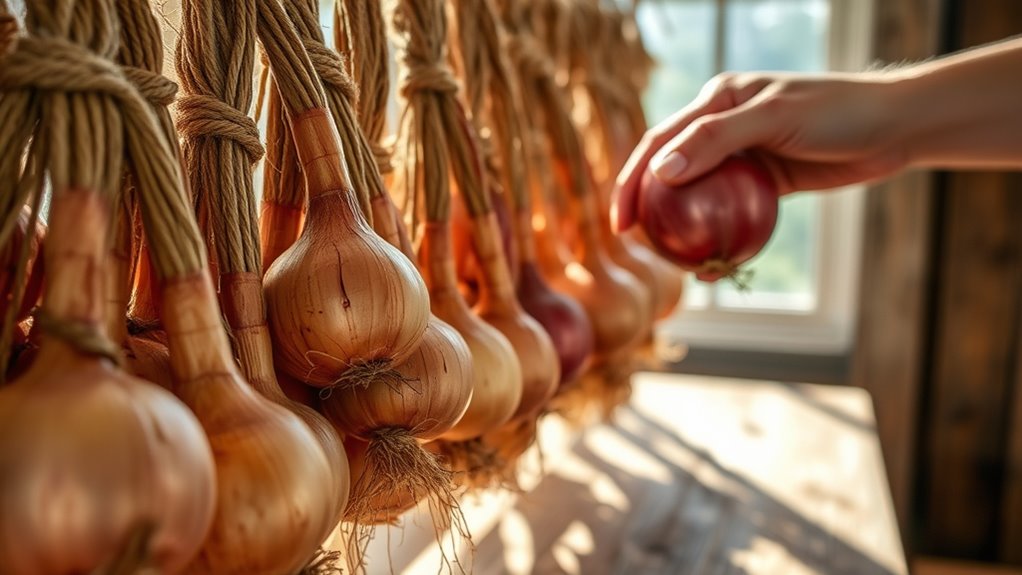
You should regularly check that your onions have good airflow to prevent excess moisture buildup. Keep an eye out for any signs of mold or rot, especially in humid conditions. Staying vigilant guarantees your onions cure properly and stay fresh longer.
Check for Proper Airflow
Ensuring proper airflow during the curing process is essential to prevent mold and rot. Good airflow patterns help keep moisture levels in check and promote even drying. To achieve this, use effective ventilation techniques, such as positioning onions in a well-ventilated area with cross-breezes. Regularly check that air circulates freely around each bulb, avoiding overcrowding. Here are key points to consider:
- Maintain consistent airflow without creating strong drafts
- Use fans or vents if natural ventilation is insufficient
- Space onions adequately to promote circulation
- Monitor for stagnant air pockets that can cause moisture buildup
Inspect for Mold Growth
Regularly inspecting onions during curing helps catch mold growth early before it spreads. Use inspection techniques like gently handling each onion to check for soft spots, discoloration, or fuzzy white or gray patches, which indicate mold. Mold prevention starts with ensuring proper airflow and avoiding excess moisture, but ongoing inspection is essential. Look closely at the necks and skins, as mold often begins there. If you spot mold, isolate affected onions immediately to prevent contamination. Remove moldy layers carefully and discard them. Maintaining a clean, dry environment minimizes mold risks. Consistent inspection keeps you aware of potential issues, allowing prompt action to protect your onions’ quality and extend their storage life. Staying vigilant is key to successful long-term storage.
Determining When Onions Are Fully Cured
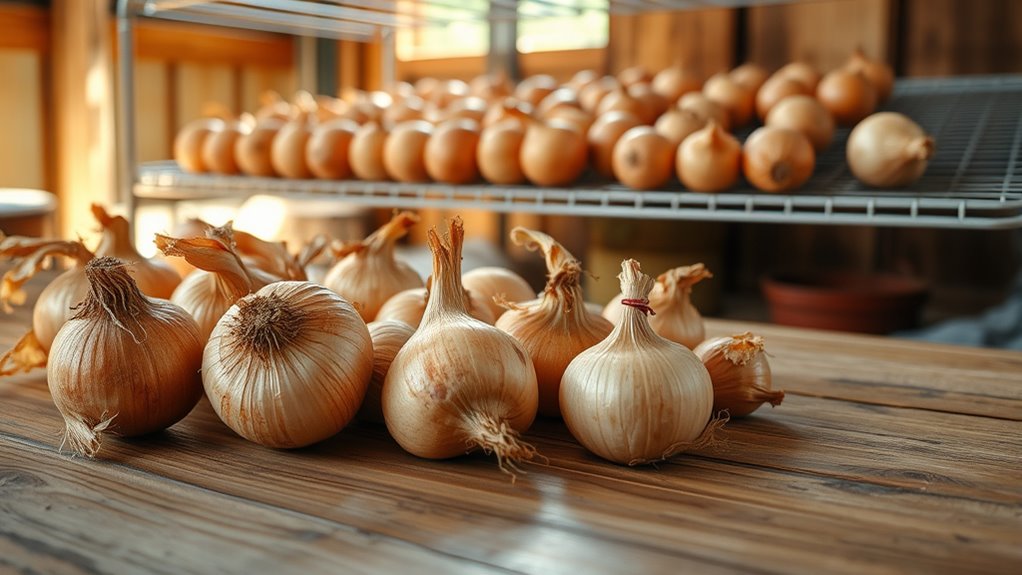
Knowing when onions are fully cured is essential for successful long-term storage. Proper curing guarantees the onion flavor develops and that different onion varieties can withstand storage without spoiling. To determine if your onions are ready, look for these signs:
Curing onions properly ensures they develop flavor and store without spoiling.
- The necks are completely dry and tight
- The outer skins are papery and firm
- There’s no moisture or soft spots
- The tops easily slip off without resistance
Curing time varies depending on onion varieties and environment, but generally takes 10-14 days. Fully cured onions will have a durable skin, indicating they’re ready to store. Properly cured onions resist rot and maintain their flavor longer, making them ideal for long-term storage.
Storing Cured Onions for Long-Term Use
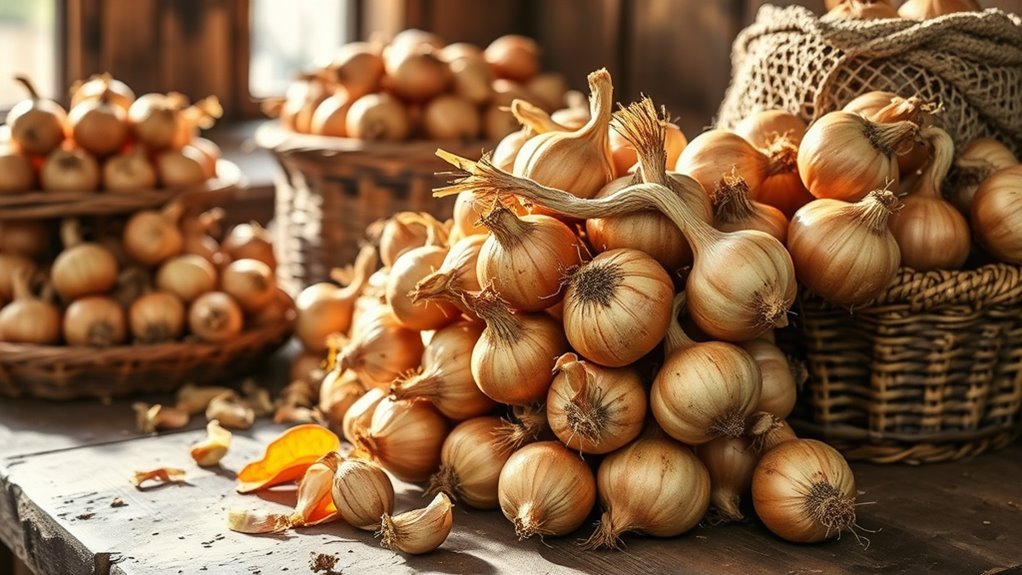
Once your onions are fully cured, proper storage methods can keep them fresh for months. The key is understanding different onion varieties, as some, like yellow onions, store longer than sweet or red onions. After curing using the right techniques—such as hanging them in a cool, dry, well-ventilated area—you should select a suitable storage environment. Store onions in a mesh bag, basket, or open crate to guarantee good airflow. Keep them in a dark, cool place with temperatures between 32-40°F (0-4°C) and low humidity. Avoid storing onions near potatoes or other produce that releases moisture or gases. Regularly check for signs of spoilage, and remove any onions that develop mold or sprouting. Proper storage extends their shelf life considerably.
Troubleshooting Common Curing Issues
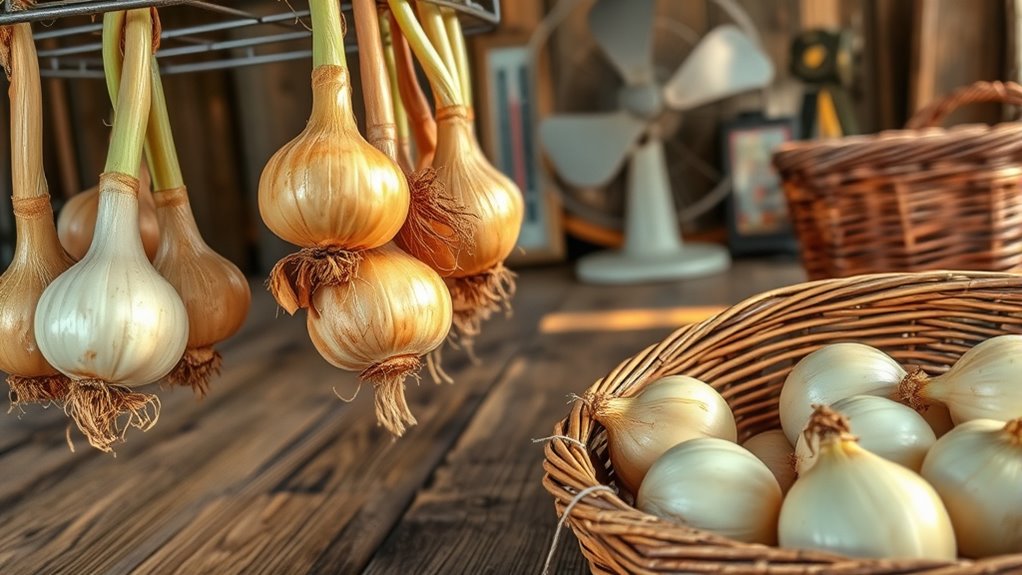
Even with careful curing, you might encounter issues like mold, sprouting, or rotting. These problems often stem from improper storage conditions or selecting unsuitable onion varieties. To troubleshoot, focus on pest prevention by inspecting onions regularly for pests or damage. Proper airflow during curing helps prevent mold growth, especially in humid environments. Using the right onion varieties suited for storage minimizes sprouting and decay.
Consider these tips:
- Ensure onions are fully dry before storage to prevent rot
- Store in a cool, dark, and well-ventilated area
- Separate damaged or soft onions to avoid spreading issues
- Rotate stored onions regularly to check for early signs of problems
Addressing these issues promptly keeps your onions fresh longer and maintains quality.
Frequently Asked Questions
How Long Can Cured Onions Be Stored Without Spoiling?
Cured onions can typically be stored for about 1 to 3 months without spoiling, depending on storage conditions. To maximize storage duration and prevent spoilage, keep onions in a cool, dry, well-ventilated area. Proper curing helps prevent moisture buildup, which can lead to rot. Regularly check your stored onions for any signs of spoilage, and remove any that show softness or mold to extend their shelf life.
What Are Signs of Improperly Cured Onions?
When inspecting your onions, look for signs of improperly cured onions. If you notice moisture accumulation or a soft texture, it indicates they weren’t cured properly. Proper curing should result in dry, papery skins and firm bulbs. If the onions are damp or feel mushy, they’re at risk of spoiling quickly. Address these issues by ensuring you cure onions thoroughly and store them in a cool, dry place.
Can Curing Be Done Indoors or Only Outdoors?
Thinking you’re limited to outdoor curing? Think again! Indoor curing is perfectly possible if you create a proper curing environment. Find a cool, dry, well-ventilated spot inside your home—like a garage or shed—and hang or lay out your onions. This controlled environment helps prevent mold and rot, ensuring your onions cure evenly and stay delicious for long-term storage. Who knew indoor curing could be so simple?
Are There Specific Onion Varieties Better Suited for Long-Term Storage?
You should choose onion varieties with firm bulbs and dry skins for long-term storage. Heirloom onions often have better flavor profiles and store longer if cured properly, while hybrids may be more uniform but sometimes less durable. Consider your flavor preferences and storage needs; heirlooms tend to have richer tastes, but hybrids can offer convenience. Select the right variety based on these factors for ideal long-term storage success.
How Do I Prevent Mold During the Curing Process?
Think of curing onions as guiding a delicate dance, where mold is an unwelcome partner. To prevent mold, you should employ mold resistant techniques like ensuring proper airflow around your onions. Keep them in a well-ventilated space, avoid high humidity, and turn them gently as they cure. These steps help the onions breathe freely, making mold less likely to take hold and ensuring your harvest stays fresh longer.
Conclusion
By carefully guiding your onions through each gentle step, you’ll transform them into resilient treasures, ready to stand the test of time. Think of curing as softly wrapping each bulb in a cozy, protective blanket, ensuring they remain vibrant and ready for future kitchens. With patience and attention, your harvest will blossom into a long-lasting bounty, quietly awaiting to enrich your meals when you need them most.

